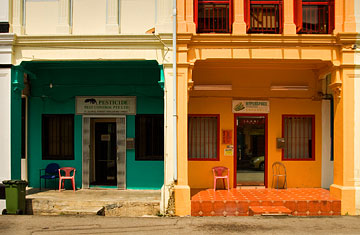
Traditional Peranakan shophouse, Kampong Glam, Singapore
The irony is both sad and delicious. The Little Nyonya, a Singaporean television serial about a Chinese Peranakan family that concluded in the middle of January, was told entirely in Mandarin, a language whose creeping bid for dominance in Singapore has lately eclipsed Baba Malay — the pidgin Malay at the heart of Peranakan culture. But in a sly act of revenge, the immensely popular serial triggered a boomlet in all things Peranakan — like the batik fabrics Peranakan women used to stitch their sarong kebayas, worn most famously by Singapore Airlines' stewardesses, or the lavender-and-purple-colored porcelain bowls from which they doled out their quivering, jelly-like sweets and spicy laksa soups.
Like laksa — a coconut-milk-and-prawn-laden broth thickened by the spices of China, Malaysia and India — Peranakan culture has been simmering since the Chinese began migrating to the Straits in the early 16th century. Originally small-time traders under the Portuguese colonialists of Malacca, the Chinese Peranakans subsequently parlayed their mastery of Malay and English to become compradore merchants under British rule, spawning a prosperous Anglophile and anglophone class that aspired to attend Oxford and Cambridge but which, at the same time, spoke among itself in Baba Malay. (See 10 things to do in Singapore.)
From the late 19th century onward, when waves of poorer and hungrier Hokkien- and Teochew-speaking immigrants began washing up in Singapore, the dominance of the early Peranakans began to slowly decline. But their culture hasn't vanished, and those who want a glimpse of the Peranakan legacy should begin on foot in the residential Emerald Hill neighborhood of Singapore. The houses that wealthy Peranakan families built there are still adorned with the fretted arches and colorful ornamental tiles they borrowed partly from colonial Portugal. (See pictures of Singapore.)
From Emerald Hill, one can take a bus, underground train or taxi for the short trip to the Bras Basah area. There, inside the premises of an old school, is a new Peranakan Museum, www.peranakanmuseum.sg, located within walking distance of the Singapore River and the pubs and restaurants of Boat Quay. The museum itself — painted in the sun-splashed pastels that have seeped into Peranakan fabrics, craftwork and confectionery — is an airy delight, and its vivid recreations of Peranakan household life a pleasure to explore.
Peranakan influence has retreated from many areas of Singapore life, but its hold over the Singaporean stomach is still strong. Peranakan food can be sampled in the city's thousands of low-cost hawker centers. For connoisseurs, the East Coast neighborhood of Katong is where the best laksa is served — traditionally enjoyed in chipped porcelain bowls while seated on plastic stools on the footpath. (See the top 10 food trends of 2008.)
To sample the truly refined subtleties of Peranakan food and its interplay of influences, head for the Blue Ginger restaurant, tel: (65) 6222 3928, in the city's Tanjong Pagar area. Blue Ginger is known for seafood, and the specialty of the house is shelled crayfish, deep-fried and topped with a cloyingly sweet, caramelized peppercorn sauce. Served with rice, it ought to be accompanied by Chinese water spinach, cooked in a chili-infused shrimp paste known as belachan. For dessert, go for the sago gula melaka, a mixture of boiled sago, warm coconut milk, palm sugar and shaved ice. The cost of an average dinner for two (without alcohol) is around $50, a modest tariff for food that is invariably sedap. That's Baba Malay for "delicious," and a word that will hopefully live for a long time yet.
See 50 authentic American travel experiences.
Got an awful travel gripe? The Avenger may be able to sort it out for you. Click here to tell us your problem.
